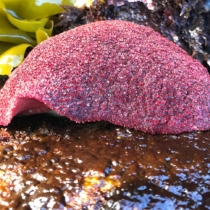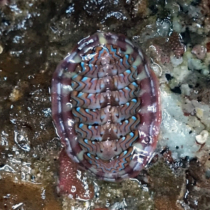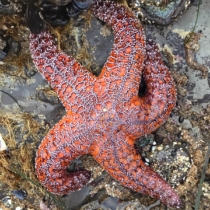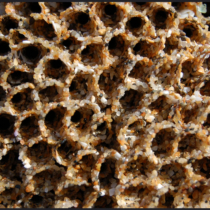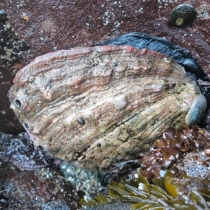So Long and Thanks for All The Fish!!
August 2024

Over the past six years, More

LiMPETS goes to Western Society of Naturalists
December 2022
The LiMPETS team was thrilled to attend and present at the 2022 Western Society of Naturalists (WSN) Conference in Oxnard, California. More

2022 Eyes In Sanctuaries
November 2022
The LiMPETS Network celebrated its 20th anniversary with “Eyes In Sanctuaries” stewardship-building monitoring events along the California coast. More

LiMPETS 2020-21 Annual Report Infographic
December 2021
The LiMPETS Team summarized education and science highlights for 2020-21 in an infographic. Teaching during the Covid-19 Pandemic has been challenging for everybody. However, we all were able to adapt and increase our flexibility in a virtual world that we now know as distance learning. The LiMPETS program is very thankful to have been able to provide quality virtual field trips and programs! We couldn’t have done it without the support and participation of our students and teachers!

Farallones LiMPETS Coordinator honored as 2020 Naturalist of the Year by Western Society of Naturalists
November 2020
Dr. Rosemary Romero, Farallones LiMPETS Coordinator, was honored at the 101st Western Society of Naturalists (WSN) Annual Meeting Nov 5 – 7, 2020. Rosemary was awarded the prestigious Naturalist of the Year Award for her efforts to “define our future by inspiring young people with the wonders and sheer joy of natural history.” Rosemary is a dedicated researcher and educator, working with K-16 students and educators, to expand their horizons so they have a better understanding of natural history, community-based science and long term monitoring.

Students Present at Scientific Conference
December 2019
LiMPETS students presented their research among more than 25,000 scientists at the American Geophysical Union Conference in San Francisco on December 12, 2019. High school students from the Branson School displayed a poster using LiMPETS rocky intertidal data and had the opportunity to meet Deputy NOAA Administrator and retired Rear Admiral of the U.S. Navy Tim Gallaudet, Ph.D.

LiMPETS article on Owl limpets in Between Tides
November 2019
Greater Farallones LiMPETS Coordinator, Rosemary Romero, wrote an article on Owl limpets featured in the Oct 2019 issue of Between Tides, the newsletter produced by Friends of Fitzgerald Marine Reserve. The article includes natural history of these gardening snails and explains the owl limpet results we presented at the World Congress of Malacology and included in our 2019 Infographic. This year LiMPETS is contributing data to the 10 year review of California’s Marine Protected Areas.
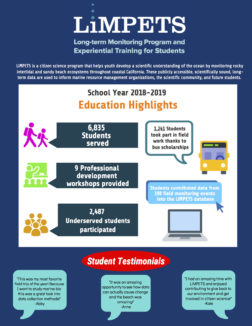
LiMPETS 2018-19 Annual Report Infographic
November 2019
The LiMPETS Team summarized education and science highlights for 2018-19 in an infographic. Some science highlights include seasonal changes in Pacific mole crabs at Ocean Beach, Ochre star densities in Central California before during and after the sea star wasting mortality in 2013-2014, and a comparison of Owl limpet size distributions inside and outside California Marine Protected Areas in Central and North Central California.

LiMPETS presents student data at World Congress of Malacology!
August 2019
Pacific Grove LiMPETS Coordinator, Hannah Sarver, presented student-collected Owl limpet data at the World Congress of Malacology Meeting in Asilomar, CA on August 15, 2019. The LiMPETS team compared size and abundance of owl limpets inside and outside of California State Marine Protected Areas (MPAs). Owl limpets are important in structuring rocky intertidal communities, as larger individuals are territorial females that clear space through grazing and bulldozing. Because of their large size, people commonly harvest them for food. Studies have found that preferentially harvesting the largest individuals shifts local population structures to include smaller, slower growing individuals. Student-collected data from two pairs of protected and unprotected sites in the central and north central coast collected over five years reflect similar trends, as individuals larger than 5.5 cm were largely absent at unprotected sites. Owl limpets within MPAs were often found at sizes ranging from 2.5-10cm. Students will continue to monitor owl limpets while learning the importance of MPAs.

Updated Field Guide for 2019!
June 2019
We updated our field guide to match our data sheets and include more pictures to make it easier to identify organisms while monitoring with LiMPETS! The 2019 update focuses only on the taxa we monitor for the LiMPETS program and these groups have changed since 2012 based on recommendations made by our science advisory panel.
Download the 2019 updated LiMPETS Field Guide here
Download the 2012 LiMPETS Field Guide with more intertidal organisms here



